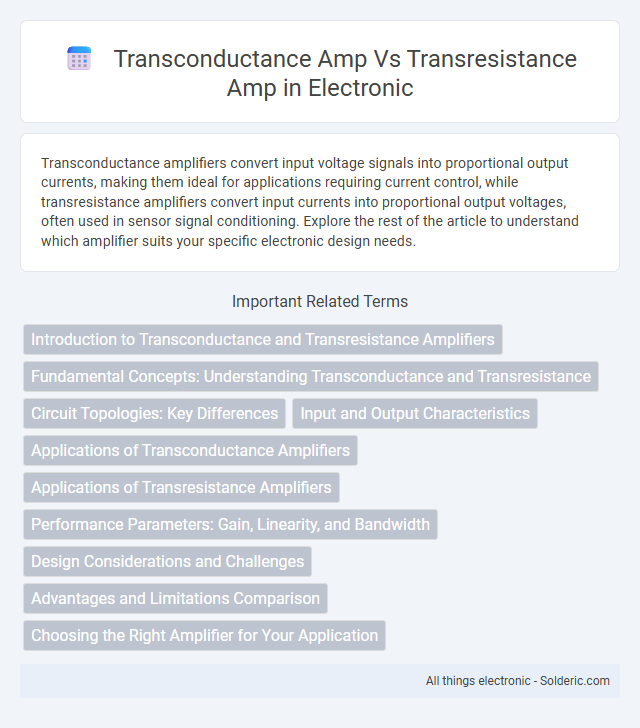Transconductance amplifiers convert input voltage signals into proportional output currents, making them ideal for applications requiring current control, while transresistance amplifiers convert input currents into proportional output voltages, often used in sensor signal conditioning. Explore the rest of the article to understand which amplifier suits your specific electronic design needs.
Comparison Table
| Feature | Transconductance Amplifier | Transresistance Amplifier |
|---|---|---|
| Definition | Converts input voltage to output current | Converts input current to output voltage |
| Transfer Function | Output Current (Iout) = gm x Input Voltage (Vin) | Output Voltage (Vout) = Rm x Input Current (Iin) |
| Unit | Siemens (S) | Ohms (O) |
| Primary Use | Voltage-to-current conversion, RF amplifiers, analog circuits | Current-to-voltage conversion, photodiode amplifiers, sensors |
| Typical Applications | Voltage-controlled current sources, mixers | Transimpedance amplifiers, optical detectors |
| Input | Voltage | Current |
| Output | Current | Voltage |
| Feedback Type | Current feedback | Voltage feedback |
Introduction to Transconductance and Transresistance Amplifiers
Transconductance amplifiers convert input voltage signals into proportional output currents, characterized by their transconductance gain (gm) typically expressed in siemens (S). Transresistance amplifiers, also known as current-to-voltage converters, generate output voltage proportional to input current, defined by their transresistance gain (Rm) in ohms (O). Both amplifier types play crucial roles in analog signal processing, enabling precise control of current-voltage relationships in sensor interfaces and communication systems.
Fundamental Concepts: Understanding Transconductance and Transresistance
Transconductance amplifiers convert input voltage to output current, characterized by the transconductance parameter (gm), which defines the ratio of output current to input voltage. Transresistance amplifiers convert input current to output voltage, with transresistance (rm) representing the ratio of output voltage to input current. Your choice between these amplifiers depends on whether you need to control current from a voltage input or voltage from a current input, critical in sensor interfacing and analog circuit design.
Circuit Topologies: Key Differences
Transconductance amplifiers convert input voltage signals into proportional output currents, typically structured with voltage-controlled current source topologies using operational transconductance amplifiers (OTAs). Transresistance amplifiers, conversely, transform input currents into output voltages, employing current-to-voltage converter topologies often implemented with operational amplifiers and feedback resistors. The fundamental circuit topology difference lies in their input-output relationships and feedback configurations; transconductance amps emphasize voltage-to-current conversion with high input impedance, while transresistance amps focus on current-to-voltage conversion with low input impedance.
Input and Output Characteristics
Transconductance amplifiers convert input voltage into output current, featuring high input impedance and a current output proportional to the input voltage, which suits voltage-to-current conversion tasks. Transresistance amplifiers accept input current and provide an output voltage, characterized by low input impedance and high output voltage gain for current-to-voltage conversion applications. Your choice between these amplifiers depends on the required signal conversion type and the impedance matching needed for optimal circuit performance.
Applications of Transconductance Amplifiers
Transconductance amplifiers are widely used in analog signal processing, including voltage-to-current conversion, and serve as essential components in operational transconductance amplifiers (OTAs) for adjustable gain control in filters and oscillators. These amplifiers are pivotal in audio and RF circuits for impedance matching and signal modulation. Their ability to convert input voltage variations into proportional output current makes them indispensable in sensor interfacing and communication systems.
Applications of Transresistance Amplifiers
Transresistance amplifiers are widely used in photodiode-based optical sensing applications due to their ability to convert small input currents into proportional output voltages with high sensitivity and low noise. They are essential in instrumentation for biosensors, light detection systems, and fiber optic communication receivers where precise current-to-voltage conversion improves signal integrity. These amplifiers also find applications in medical devices and spectroscopy, enabling accurate measurement of low-level currents generated by sensors.
Performance Parameters: Gain, Linearity, and Bandwidth
Transconductance amplifiers offer gain defined as output current per input voltage (siemens), excelling in linearity due to stable transconductance over frequency, with bandwidth typically limited by input capacitance and parasitic elements. Transresistance amplifiers provide gain as output voltage per input current (ohms), featuring high linearity with low distortion in current-to-voltage conversion, while their bandwidth depends on feedback resistor and input capacitance values, often extending higher than transconductance amps. In applications demanding precise gain and wide bandwidth, transresistance amps outperform in current signal fidelity, whereas transconductance amps are preferable for voltage control and stability across frequency ranges.
Design Considerations and Challenges
Transconductance amplifiers are designed to convert input voltage to output current, requiring careful control of input impedance to ensure accurate voltage-to-current conversion and stability. Transresistance amplifiers convert input current to output voltage, demanding low input impedance and precise feedback network design to maintain linearity and minimize noise. Both amplifier types face challenges in bandwidth optimization, noise reduction, and maintaining linearity under varying load and signal conditions.
Advantages and Limitations Comparison
Transconductance amplifiers convert input voltage to output current with high linearity and wide bandwidth, making them ideal for voltage-to-current conversion applications, but they are limited by output impedance and noise sensitivity. Transresistance amplifiers convert input current to output voltage, offering simplicity and high gain for photodiode signal amplification, though their performance can be constrained by bandwidth and stability issues. The choice depends on the specific requirement of voltage or current interfacing, with transconductance amps excelling in current drive scenarios and transresistance amps preferred where precise current-to-voltage conversion is needed.
Choosing the Right Amplifier for Your Application
Transconductance amplifiers convert input voltage to output current, making them ideal for applications such as driving capacitive loads or converting sensor outputs to current signals. Transresistance amplifiers convert input current to output voltage, offering precise current-to-voltage conversion crucial in photodiode and sensor signal conditioning. Selecting the appropriate amplifier depends on the signal type, load conditions, and accuracy requirements specific to your application.
Transconductance amp vs Transresistance amp Infographic

 solderic.com
solderic.com